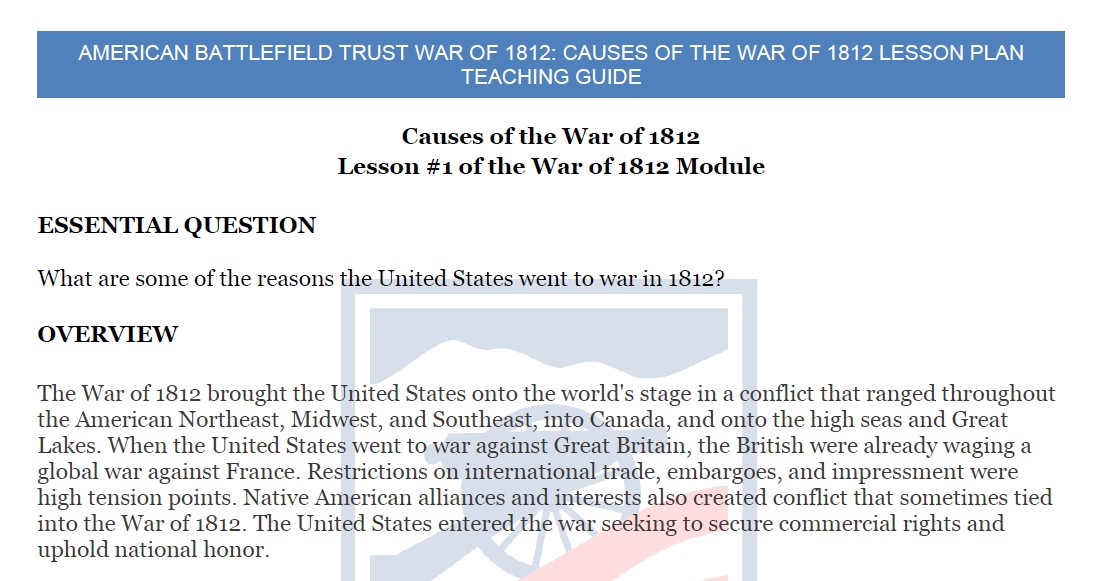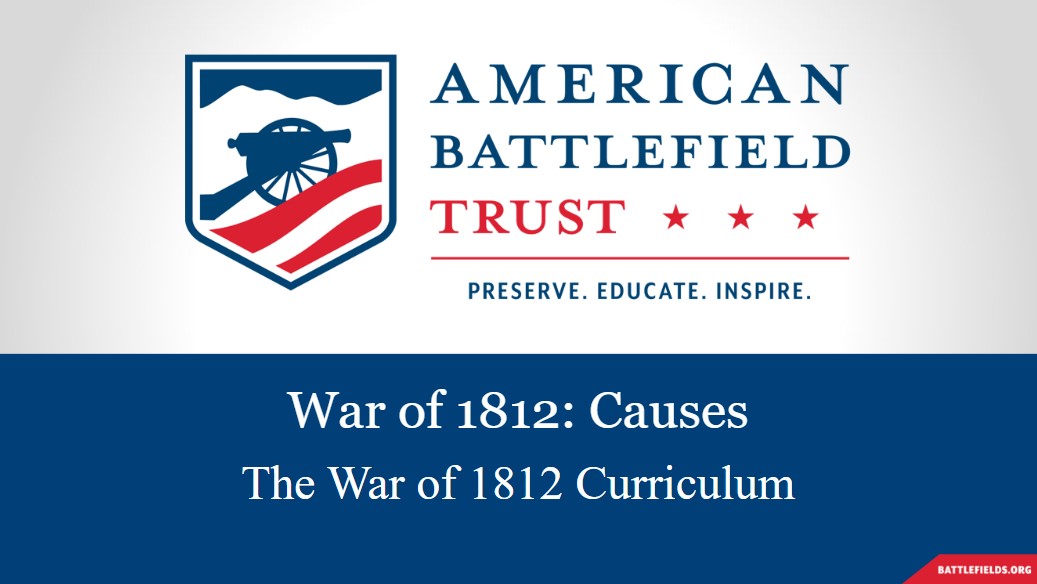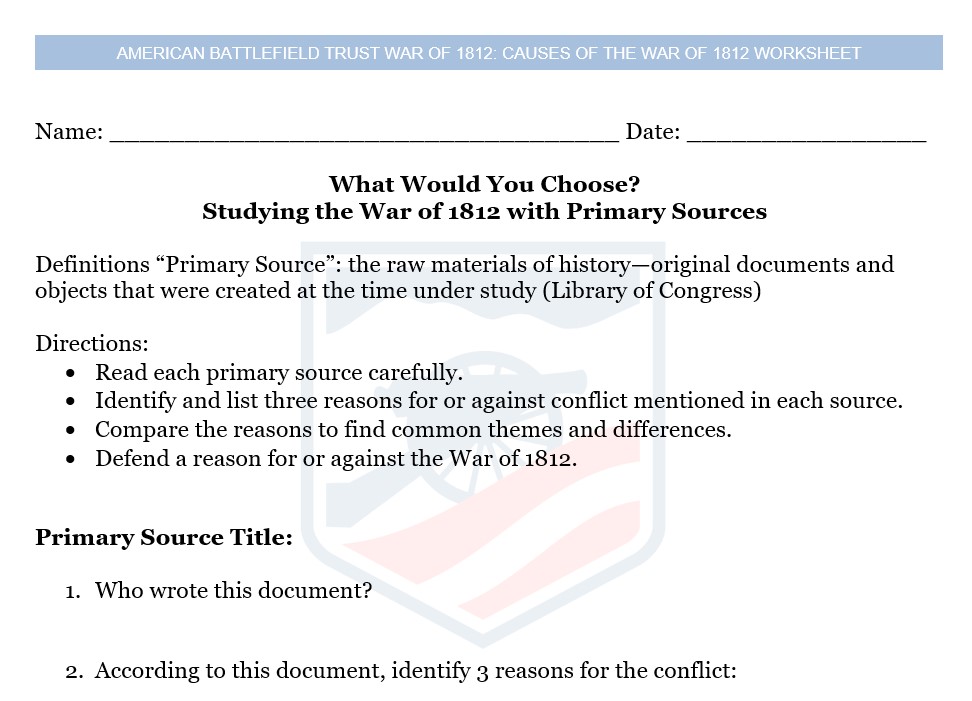
Causes of the War of 1812 Lesson Plan
A lesson plan for use in middle and high school classrooms.
The War of 1812 brought the United States onto the world's stage in a conflict that ranged throughout the American Northeast, Midwest, and Southeast, into Canada, and onto the high seas and Great Lakes. When the United States went to war against Great Britain, the British were already waging a global war against France. Restrictions on international trade, embargoes, and impressment were high tension points. Native American alliances and interests also created conflict that sometimes tied into the War of 1812. The United States entered the war seeking to secure commercial rights and uphold national honor.
This Lesson Plan can be used as a prepared resource by following this curriculum plan which aligns to NCSS and Common Core Standards.
This Lesson Plan's assets can also be used on their own as supplemental resources. The display format is prepared for easy access, exploring, and learning.
Upon completion of this lesson, the students will be able to:
1. Knowledge
- Explain reasons for the War of 1812.
- Discuss the political and international challenges the United States faced in the early 19th Century.
2. Comprehension/Application/Analysis
- Read and research through primary source documents exploring different reasons and perspectives on the causes of the War of 1812.
3. Evaluation
- Evaluate the causes of the War of 1812 and defend a personal opinion about the causes.
Check out the Lesson Plan Teaching Guide for more instructions on using the prepared Lesson Plan.
Lesson Plan Primary Source Activity:
- Use the Lesson’s PowerPoint to explore the context and history; the PowerPoint introduces Essential Questions and lays foundational knowledge about the conflict – highlighting both the United States conflict with Britain and Native American conflicts which had ties and alliances in the causes of the War of 1812.
- Watch the “What Caused the War of 1812?” Video
- Students will examine the primary sources and decide if they would have supported the War of 1812 if they lived in the United States at that time.
- Distribute the primary source worksheet and have the students select primary sources for this lesson. Students may work on their own or as a group.
- Students may present their short argument verbally or written.
- 7 selected primary sources are available under the “Primary Source” section of this lesson plan page. There is a selection of pro-war, anti-war, and Native American perspectives in the selected sources.
OPTIONAL HOMEWORK/ASSESSMENT/ADDITIONAL ACTIVITIES:
Option 1: War of 1812 Era Timeline
Using the 9 Articles featured in this lesson plan, students will research and create a list timeline of events that happened in the United Stations and internationally in the era, leading to the declaration of war in 1812. (This timeline may also be helpful: War of 1812 Timeline) Have the students highlight domestic or foreign events and discuss how they may or may not be connected and leading to the War of 1812.
Option 2: Biography and Letter
Have students select a person from the War of 1812 era. (There are biographies featured on the lesson plan page and additional War of 1812 biographies here on the American Battlefield Trust website.) The students will note if this historical figure supported or opposed the War of 1812 and then write a letter as though this historical figure is explaining his or her view about the conflict.
Common Core State Standards- ELA & History/Social Studies
Grades 6-8
- Key Ideas & Details:
- CCSS.ELA-LITERACY.RH.6-8.1
- Cite specific textual evidence to support analysis of primary and secondary sources.
- CCSS.ELA-LITERACY.RH.6-8.2
- Determine the central ideas or information of a primary or secondary source; provide an accurate summary of the source distinct from prior knowledge or opinions.
- CCSS.ELA-LITERACY.RH.6-8.1
- Craft and Structure:
- CCSS.ELA-LITERACY.RH.6-8.6
- Identify aspects of a text that reveal an author's point of view or purpose (e.g., loaded language, inclusion or avoidance of particular facts).
- CCSS.ELA-LITERACY.RH.6-8.6
Grades 9-10
- Key Ideas & Details:
- CCSS.ELA-LITERACY.RH.9-10.1
- Cite specific textual evidence to support analysis of primary and secondary sources, attending to such features as the date and origin of the information.
- CCSS.ELA-LITERACY.RH.9-10.2
- Determine the central ideas or information of a primary or secondary source; provide an accurate summary of how key events or ideas develop over the course of the text.
- CCSS.ELA-LITERACY.RH.9-10.3
- Analyze in detail a series of events described in a text; determine whether earlier events caused later ones or simply preceded them.
- CCSS.ELA-LITERACY.RH.9-10.1
- Craft and Structure:
- CCSS.ELA-LITERACY.RH.9-10.6
- Compare the point of view of two or more authors for how they treat the same or similar topics, including which details they include and emphasize in their respective accounts.
- CCSS.ELA-LITERACY.RH.9-10.6
- Integration of Knowledge and Ideas:
- CCSS.ELA-LITERACY.RH.9-10.9
- Compare and contrast treatments of the same topic in several primary and secondary sources.
- CCSS.ELA-LITERACY.RH.9-10.9
Grades 11-12
- Key Ideas & Details:
- CCSS.ELA-LITERACY.RH.11-12.2
- Determine the central ideas or information of a primary or secondary source; provide an accurate summary that makes clear the relationships among the key details and ideas.
- CCSS.ELA-LITERACY.RH.11-12.2
Craft and Structure:
- CCSS.ELA-LITERACY.RH.11-12.5
- Analyze in detail how a complex primary source is structured, including how key sentences, paragraphs, and larger portions of the text contribute to the whole.
- CCSS.ELA-LITERACY.RH.11-12.6
- Evaluate authors' differing points of view on the same historical event or issue by assessing the authors' claims, reasoning, and evidence.
- CCSS.ELA-LITERACY.RH.11-12.5
Integration of Knowledge and Ideas:
- CCSS.ELA-LITERACY.RH.11-12.9
- Integrate information from diverse sources, both primary and secondary, into a coherent understanding of an idea or event, noting discrepancies among sources.
- CCSS.ELA-LITERACY.RH.11-12.9
Social Studies - National Council for the Social Studies
- Theme 2: Time, Continuity, and Change
- Theme 3: People, Places, and Environments
- Theme 5: Individuals, Groups, and Institutions
- Theme 6: Power, Authority, and Governance
- Theme 9: Global Connections
- Theme 10: Civic Ideals and Practices
This Lesson plan
contains the following:
3 Activities | 24 Resources
Audience: Middle school | High school





